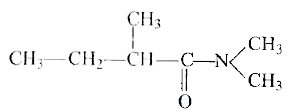H3C−CH2−CH3∣CH−C∣∣O−NH2Br2+KOH−−−−−−−−−→ΔA1.CH3I(excess)−−−−−−−−−−−−→2.AgOH,ΔB
The major product (B) is :
CH3−CH2−CH=CH2

H3C−CH=CH−CH3

The correct Answer is:A
To solve the problem step by step, we will analyze the reactions described in the question.
Step 1: Identify the starting compound
The starting compound is:
H3C−CH2−CH3|CH−||OC−NH2
Step 2: Reaction with Br₂ and KOH (Hofmann degradation)
When this compound reacts with bromine (Br₂) and potassium hydroxide (KOH) in the presence of heat, it undergoes the Hofmann degradation. In this reaction, the carbonyl group (C=O) is removed, and the amine group (NH₂) is attached to the adjacent carbon atom.
The reaction can be summarized as follows:
- The carbonyl group (C=O) is omitted.
- The NH₂ group is now attached to the carbon adjacent to the one that was originally part of the carbonyl.
This gives us compound A:
H3C−CH2−CH2−NH2
or simply:
CH3−CH2−CH2−NH2
Step 3: Reaction with excess CH₃I
Next, compound A reacts with excess methyl iodide (CH₃I). In this reaction, the hydrogen atom on the nitrogen (NH₂) is replaced by a methyl group (CH₃). Since there is excess CH₃I, the nitrogen can be fully quaternized, resulting in:
CH3−CH2−CH2−N(CH3)+3
Step 4: Reaction with AgOH and heat
The next step involves the reaction of the quaternized nitrogen compound with silver hydroxide (AgOH) in the presence of heat. In this reaction, the hydroxide ion (OH⁻) attacks the nitrogen, leading to the formation of a double bond and the release of a methyl group.
The reaction can be summarized as follows:
- The nitrogen loses a methyl group and forms a double bond with the adjacent carbon.
This results in the final product B:
CH3−CH2−CH=CH2
Final Answer
The major product (B) is:
CH3−CH2−CH=CH2
The starting compound is:
H3C−CH2−CH3|CH−||OC−NH2
When this compound reacts with bromine (Br₂) and potassium hydroxide (KOH) in the presence of heat, it undergoes the Hofmann degradation. In this reaction, the carbonyl group (C=O) is removed, and the amine group (NH₂) is attached to the adjacent carbon atom.
- The carbonyl group (C=O) is omitted.
- The NH₂ group is now attached to the carbon adjacent to the one that was originally part of the carbonyl.
H3C−CH2−CH2−NH2
or simply:
CH3−CH2−CH2−NH2
Next, compound A reacts with excess methyl iodide (CH₃I). In this reaction, the hydrogen atom on the nitrogen (NH₂) is replaced by a methyl group (CH₃). Since there is excess CH₃I, the nitrogen can be fully quaternized, resulting in:
CH3−CH2−CH2−N(CH3)+3
The next step involves the reaction of the quaternized nitrogen compound with silver hydroxide (AgOH) in the presence of heat. In this reaction, the hydroxide ion (OH⁻) attacks the nitrogen, leading to the formation of a double bond and the release of a methyl group.
- The nitrogen loses a methyl group and forms a double bond with the adjacent carbon.
CH3−CH2−CH=CH2
The major product (B) is:
CH3−CH2−CH=CH2
Similar Questions
Knowledge Check
- Question 1 - Select One
CH3−CH2−O∣∣C−CH3∣C∣CH3−CH3PhCO3H−−−−−→A,A will be
ACH3−CH2−O−O∣∣C−CH3∣C∣∣CH3−CH3BCH3−CH2−O∣∣C−O−CH3∣C∣CH3−CH3CCH3−CH2−O∣∣C−CH3∣−∣CH3O−CH3DNone of these - Question 2 - Select One
In the given reaction CH3−CH2−NH−CH2−CH2−Cl(i)CH3I(excess)−−−−−−−−−−−−−→(ii)AgOH/Δ[X] is the major product, [X] will be:
ACH2=CH2BCH2=CHCIC1:1 ratio of (a) and (b)DCH3−CH2−CI - Question 3 - Select One
CH3−CH∣Br−CH2−O∣∣C−CH3N2HO(4),ϴOH−−−−−−−−−−−→Δ Product:
A B
B C
C D
D
CH3−CH3∣C∣CH3−C∣BrH−CH3El mechanism−−−−−−−−−−→Δ(A)
Major product (A) isView SolutionThe IUPAC name of CH3−O∣∣C−C∣C2H5H−C∣CH3H−CH3 is
View SolutionCH3−CH2−CH2−CH2−CH3∣C∣CH3−CH2−OHH+−−→ΔA(major) product (A) is :
View SolutionCH3−CH2−Br∣C∣CH2(n−Pr)−CH3CH2−Etalc.KOH−−−−−→Amajor
View SolutionThe IUPAC name of CH3−C∣CH3H−CH2−O∣∣C−Br is
View Solution

